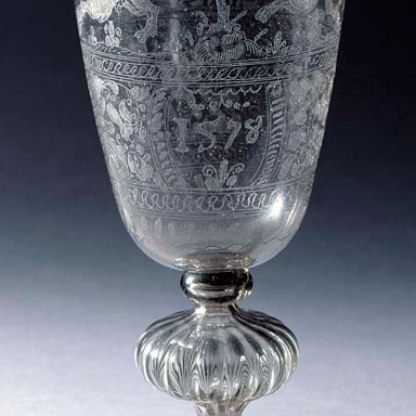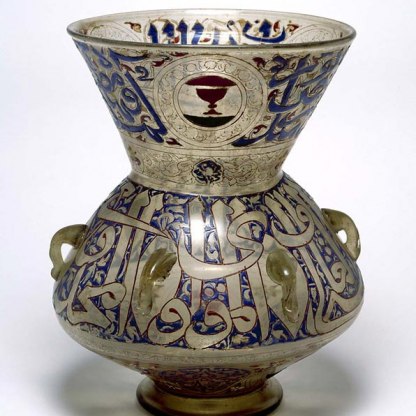Tazza

'It seems to me that all the metals must give way to glass in beauty.' The Pirotechnia of Vannoccio Biringuccio, Venice, 1540.
The glass produced on the island of Murano in the Venetian lagoon during the Renaissance was the finest and most highly valued in the world. Technically innovative and often beautifully decorated, Venetian glass was prized throughout the courts of Europe. This elegantly proportioned, shallow glass bowl speaks of the success and self-confidence of the Most Serene Republic of Venice in the fifteenth and sixteenth centuries.
Twelve gold ribs radiate from the centre, where a winged lion, holding a gospel book, is picked out in gold leaf and red, white and blue enamel. This traditional symbol for St Mark became the spiritual and political emblem of the city of Venice itself after the saint's relics were bought there in 828.
At the time that this bowl was made, the winged lion could be seen all over the Mediterranean, wherever Venetian power and trade extended. By 1500 Venice, with a population of over 100,000, was one of the four great cities of western Europe, along with Naples, Milan and Paris, and her trade routes extended as far as China. Goods from all over the known world were sold and distributed in her markets. And Venice herself produced her own luxury items, such as silk, paper, lace and soap.
But glass was arguably the city's most important industry and as the great Islamic glass centres in Syria and Egypt declined, Venice's vitreous fortunes grew. So superior was Venetian glass to that produced elsewhere and so jealously did the state guard its monopoly, that in 1285 a law was passed forbidding the export of glass-making materials from the city.
A fifteenth-century Venetian glassmaker, Angelo Barovier, is credited with the invention of cristallo, a new type of transparent glass that closely resembled rock crystal. The new technique developed rapidly, and soon crystal glasses were being decorated with enamels and gold leaf, as here.
Themes and periods
Data from our collections database
Clear glass, partly mould-blown, painted in blue, green, red, and white enamels, and gilded. Circular with mould-blown anti-clockewise wrythen gadroons on the underside, a folded lip, and low foot with folded rim. In the centre is a circular depression enamelled and gilded with the lion of St. Mark, surrounded by circles of red, green and white dots. A band of gold decoration with red, white and dark blue spots is painted on the underside. The ribs are gilded at the tip.
Unknown before Charles Brinsley Marlay (1831-1912)
Legal notes
C.B. Marlay Bequest
Acquisition and important dates
- Method of acquisition: Bequeathed
- Dates: 1912-06-18
Dating
The Venetian glasshouses were situated on the Island of Murano as a precaution against them causing a fire in the city. A lion, the symbol of the evangelist, St Mark, had been adopted as the symbol of Venice after the relics of the saint had been taken there from Alexandria in 828 AD.
Maker(s)
- Probably Unidentified Venetian glasshouse Maker
Note
The Venetian glasshouses were situated on the Island of Murano as a precaution against them causing a fire in the city. A lion, the symbol of the evangelist, St Mark, had been adopted as the symbol of Venice after the relics of the saint had been taken there from Alexandria in 828 AD.
Place(s) associated
- Murano, Venice
Materials used in production
Read more about this recordStories, Contexts and Themes
Other highlight objects you might like
Suggested Curating Cambridge products
Sign up to our emails
Be the first to hear about our news, exhibitions, events and more…







